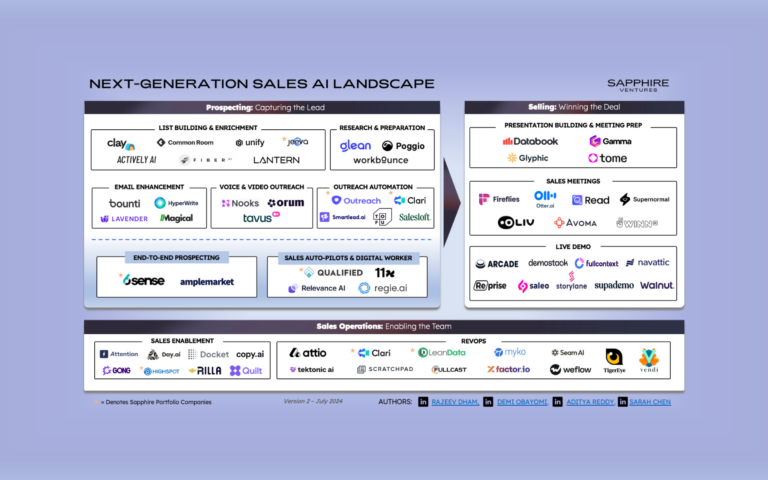Innovation in large enterprises once occurred over the course of decades, but today, that’s a luxury many enterprises no longer have. In 1965, the average company on the S&P 500 remained for 33 years. By 1990 it shrunk to 20 years, and by 2026, it’s expected to shrink to 14 years.
Rapid innovation is a prerequisite for survival.
Yet, many say enterprises don’t have what it takes. They take too long to adopt solutions and get bogged down by legacy systems. Their progress is incremental rather than disruptive.
But the biggest companies in the world aren’t sitting still. They can be catalysts for innovation and first adopters of new technology, if they understand how to create a framework for innovation within their company. At Sapphire Ventures, we collaborate regularly with corporate innovators that seek to navigate dynamic new ecosystems often populated by disruptive startups and emerging technologies.
Shakti Jauhar, head of Global HR Operations and Shared Service at PepsiCo, talks about the importance of constant innovation and created a program that helps his team evaluate and bring in new technology innovations from startups in the HR space. Called the 90/90, the program has seen early success, so I sat down with Shakti to learn more about the framework he uses to speed up startup collaboration — one that any enterprise can leverage to make fast-moving innovation part of their ethos.
Below is an excerpt from our conversation in which Shakti shares the initial steps a company should take to create a framework for working with startups.
Step 1: Create Alignment and Agree on Objectives
This first step may seem obvious, but is often overlooked. Misalignment can and will kill every attempt to innovate in the enterprise. Enterprises are complex machines that rely on many systems running in tandem. If the legal team, IT department and procurement each have conflicting priorities, it will be difficult to succeed. With the increasing trend of business driving tech adoption independent of IT, CXOs would also do well to align closely with CIOs and IT leadership on questions of specific innovation priorities, where to partner vs. build, speed of adoption, appetite for technological risk and so on.
At PepsiCo, an important alignment step is to identify a need or areas of opportunity and then present them to the startup and innovation communities for solutions. Problem statements ranged from CoEs looking to implement a new program to efficiency plays. Every six to nine months, the team would identify a small group of startups and invite them to gain alignment with stakeholders aligned to the agreed-upon problem statements. This alignment is a key enabler in the eventual success of startups graduating through the program.
Achieving alignment will put in place a realistic understanding both of what is possible and how it will play out across an organization. Working out internal problems is the foundation of an internal framework for innovation and CXOs should do this well before they bring startups into the equation.
Step 2: Ready Internal Infrastructure and Platforms
Another critical step is reviewing the infrastructure that a company has in place and updating it if necessary. As a key first step, PepsiCo has re-architected its core HR system onto a single platform across 83 countries for ~260,000 employees. This, along with other technology deployments enabled it to create the equivalent of a “plug and play” system, where new solutions could be adopted into the core platform.
Allowing some experimentation on this platform can also be an enabler of startup success. For example, partners adopted some of the ideas for startups where they have launched an app store or made an environment available for Startups to write their own APIs into an HR platform. Taking a platform-based approach has been a holy grail in the enterprise for some time, and for PepsiCo HR this infrastructure is a key ingredient to accelerate serving up innovation at scale for employees.
Step 3: Build a Blueprint
The next step is to create a blueprint which enables finding, incorporating and scaling new processes. This allows enterprises to lock in their ability to innovate for years to come and continually work with the best emerging startups in their field.
As part of the 90/90 program, participating startups commit 90 days to both deploy their solution within PepsiCo and demonstrate their ROI. This provides a clear framework for all parties to quickly evaluate success. That means PepsiCo is evaluating solutions based on how they drive broader business goals and address problem statements. For the startups, that means quickly assessing their readiness to scale to enterprise grade.
To assemble a system for scaling innovation by partnering with startups, enterprises should:
- Use their connections with VC firms, founders and angel investors to scout partnership opportunities. For example, PepsiCo’s partnership with Sapphire Ventures has exposed the company to a wide range of startups and emerging technologies that fuel its innovation roadmap.
- Specify a hard timeline for testing innovation and partnerships. This helps focus the system on accomplishing set goals. It also standardizes the process for bringing on new tech, making it repeatable.
- Focus on finding fit. When dealing with a shorter timeframe, like the 90/90 framework, big investments are not necessary. The real ROI might come from finding something that continually pays for itself in a short time.
- The goal in making a blueprint for a framework like 90/90 is to keep things moving for the enterprise and to make partnerships easier by laying out a clear vision of how successful adoption of new technology will work out.
Step 4: Lean All The Way In
Setting the wheels of innovation in motion is only half of the work in a program like this. The other half is building long-term relationships with the best new companies out there. The companies that find success in a startup-enterprise relationship are open, proactive and willing to make an investment beyond the short-term.
Enterprises also need to keep a close eye on the startups in their industry. But when so many startups fail, enterprises can be wary of spending too much time trying to dissect the space.
That’s a huge mistake. Yes, many startups don’t survive. But, over time, startups will evolve the way organizations think about innovation and agility. And ultimately one of them will end up disrupting business in a way that will be unprecedented. Leaders need to be paying close attention to their market to stay on that curve.
Set Up for Success
It’s up to large enterprises to carve out their own future. In today’s world, that means finding ways to innovate at high speeds. Although they certainly have more to coordinate than smaller companies, this doesn’t mean they’re doomed to lag behind.
Instead, savvy global enterprises like PepsiCo, are putting themselves on the forefront of innovation in their industry. They’re building long-term partnerships within the startup and venture communities, and creating a way for innovation to regularly cycle through their companies. They’re streamlining their internal processes to scale novel solutions and as they’re doing these things, they’re securing the legacy of their company for years to come.




